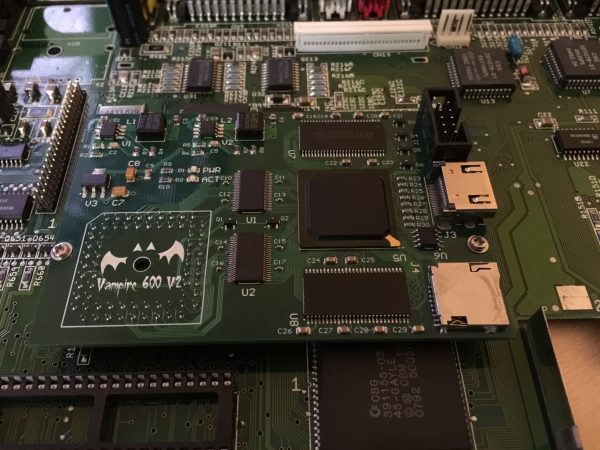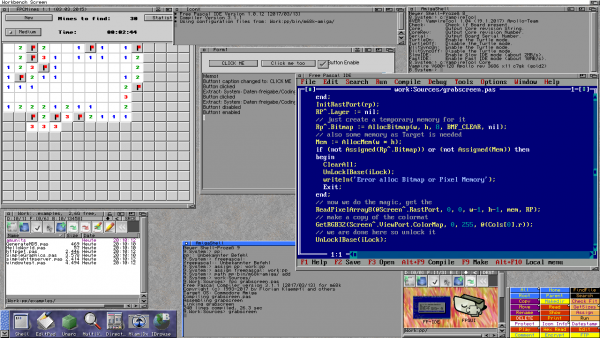I found a holder for my Vampire in the Amiga 600.
The current solution are just two little feet attached with some tiny screws.

Of course two feet always wiggle around and after transport the Amiga 600 I have to open the case and press the CPU adapter to the right position.
The holder on Thingiverse should improve that. To spoil the result it works, if it is stable on some transportation, we will see ;-).
I guess the holder is meant to use without the ROM chip holder. The holes one the lower side to attach to the mainboard are a tiny bit shifted. Therefore I had to drill some new holes. Luckily the holder has enough spare place for the Vampire so the whole thing can be moved some millimeters.

The holes for the upper part on the right side are missing (or moved to the end of the lower part, a little bit strange). But not a big problem because I used tiny self-drilling screws. It seems very tight and fixed now. I shaked the whole Amiga 600 a little bit still seems perfectly in place. We will see on next Amiga and RetroComputer Meeting in Berlin when I carry it around a while.
When I work on MUIMapparium usually I only work in Linux and test on AROS Linux-hosted. which is very convenient and fast. When starting the MUIMapparium I also tested at the end on every platform if it works and how is the speed. For the last two Releases I skipped this part, due to lack of time.
But yesterday I tried MUIMapparium on my Amiga 600 with Vampire and was shocked how slow it behave. The map moving is just not usable around a second reaction time. I downloaded/compiled older versions to check when this problem appeared. Deep in the back of my brain I guessed already that the fixed position calculation could be the reason (see here). Thats pure floating point calculation and a lot of them. I tested that on the initial implementation and it seemed not too slow, because for simple map moving and zoom only very two-three times this conversation have to be done, so the influence is not very big.
So why it’s now so slow? The difference is that before I tested with a bare MUIMapparium without any marker or tracks loaded. Marker only add a single conversation to the list. But Tracks need a conversation for every recorded (and maybe drawn) point. Remember the most GPS devices measure the position once per second, that means for an hour walk you get something about 3600 points (usually the GPS already strip them from „not moved“ points, nevertheless you get around 1000 points). For NG Amigas with their massive computing power especially on the FPU side, this is not much of a problem, 1000 fpu calculation with some hundreds MFlops are just done some milliseconds.
But on Vampire it’s a different story, no FPU, it has to use the softFPU emulation of FreePascal. This raised the question: How fast is the softFPU emulation on a Vampire in comparison to a real 68060 / 50Mhz FPU. The Vampire integer performance is much higher than the 68060 (around twice as fast, see here) but emulated FPU, there is a lot of code needed to emulate that correctly.
I used two tests for that, a simple Mandelbrot algorithm, in single and double precision and the well known SciMark from NIST. Compiled with either with FPC SoftFPU emulation or the 68881 FPU support.
Mandelbrot results (Runtimes, shorter is better)
| Test |
68060/50 MHz FPU |
68060/50Mhz SoftFPU |
Vampire SoftFPU |
Mandelbrot single precision |
0.12 s |
9.53 s |
3.81 s
|
| Mandelbrot double precision |
0.15 s |
23.72 s |
13.37 s |
When comparing the SoftFPU times of 060 and Vampire you can see the 2-3 times I experienced before already. But the (often called „very slow“) 68060 FPU leaves the SoftFPU Vampire in the dust far behind it. (In fact the dust is already settled down again, before the SoftFPU finished the calculation). Of course the errorbars for the calculations with FPU are huge, the time is too short for a reliable time measurement, but a bigger calculation just would need ages with SoftFPU 😉 and the trend is nicely visible.
Next is the SciMark, it uses various real life floating point calculation, like FFT, matrix multiplication, monte carlo simulation, if you work in science you know that stuff, if not just believe me that is what science programs do all day 😉
SciMark2 results (MFlops, higher is better)
Vampire V600 V2+ 128 MB SoftFPU code
** **
** SciMark2a Numeric Benchmark, see http://math.nist.gov/scimark **
** **
** Delphi Port, see http://code.google.com/p/scimark-delphi/ **
** **
Mininum running time = 2.00 seconds
Composite Score MFlops: 0.06
FFT Mflops: 0.03 (N=1024)
SOR Mflops: 0.12 (100 x 100)
MonteCarlo: Mflops: 0.03
Sparse matmult Mflops: 0.08 (N=1000, nz=5000)
LU Mflops: 0.02 (M=100, N=100)
Amiga1200 68060/50 FPU code
** **
** SciMark2a Numeric Benchmark, see http://math.nist.gov/scimark **
** **
** Delphi Port, see http://code.google.com/p/scimark-delphi/ **
** **
Mininum running time = 2.00 seconds
Composite Score MFlops: 2.26
FFT Mflops: 1.18 (N=1024)
SOR Mflops: 5.05 (100 x 100)
MonteCarlo: Mflops: 0.86
Sparse matmult Mflops: 1.81 (N=1000, nz=5000)
LU Mflops: 2.41 (M=100, N=100)
So it just shows the same trend. Attention: do not compare this MFlops with the theoretically MFlops most speedtests show you (like sysinfo), you can see, how different the tests behave. It depends very strong on which commands are used and how much memory bandwidth is needed.
In conclusion it shows really nicely why the MUIMapparium with a track on a Vampire is so slow currently, because of the slow SoftFPU. Very sad that the Vampire still lacks a proper FPU support. We (ChainQ and me) believe that it is possible to optimize the SoftFPU performance maybe 50% faster or even double, or lets aim for the stars.. 10 times faster than now (I do not believe that is even close to possible at all). It would still be around 5 times slower than a 68060/50 Mhz FPU, for the people believing a SoftFPU implementation could be a replacement for a native FPU in the FPGA.
That means, if it reacts very slowly on Vampire, just remove the track. 😉 I will work on this, reduce the needed calculations, (by using more memory), see at which places I could possibly go down to single precision (not much hope there ;-)) and of course reduce the number of points, in principle a LOD on the Zoomlevel.
P.S.
if you want to test SciMark you can download the FPu and SoftFPU exe from my server:SciMark FPU Version, SciMark SoftFPU Version. (I would be very interested in 68881/2 Results)
Some people ask me to supply a Version of the MUIMapparium presented yesterday. No problem, please just remember it’s heavy work in progress, not much is working currently. In principle only Mapping and searching function, but this is already nicely working on all my available Amigas. Please note the m68k-Amiga Version needs RTG (or it will just crash), OS3.1+, MUI of course and without network it’s not really useful ;-). The Amiga Version works nicely on Vampire A600 (RTG Screen) but should also work with every 68020+ Amiga with graphic card, just a little bit slow perhaps. (FPU is not needed, in contrast to Mapparium)
MUIMapparium 0.1:

MUIMapparium on AROS
I bought a neat eat toy for me. An A600 already equipped with an Vampire processor card. A Vampire is an FPGA based CPU card for Amiga 500 and Amiga 600. A while ago I thought already about to buy a Vampire card. The delivery times for it are very uncertain and seems in the order of 6 Month. I even would need to buy an A600 first, I was really to lazy to do such step with uncertain future. But I found an ready to use one one ebay. Maybe a little bit more expensive but thats fine by me, still much cheaper than a 68060 or PPC card. 😉 The capacitors are exchanged but the audio sounds strange, but not a big problem for me. Mainly I’m not interested in the speed but but in the GFX Card which comes with the FPGA on Vampire. Its the only way to get a 24bit GFX card into a keyboard Amiga (except the very seldom BVision for A1200). Of course my for me very interesting if freepascal and it’s programs work with it and good news on this side, it’s working nicely. The only problem (like on my A1200) is the slow harddisk which makes it much slower then UAE but as I read the next firmware should improve that a lot. Of course a screenshot (done with a screenshot program I wrote in FP-IDE directly on my A1200 some weeks before)

FPC on a Vampire A600



